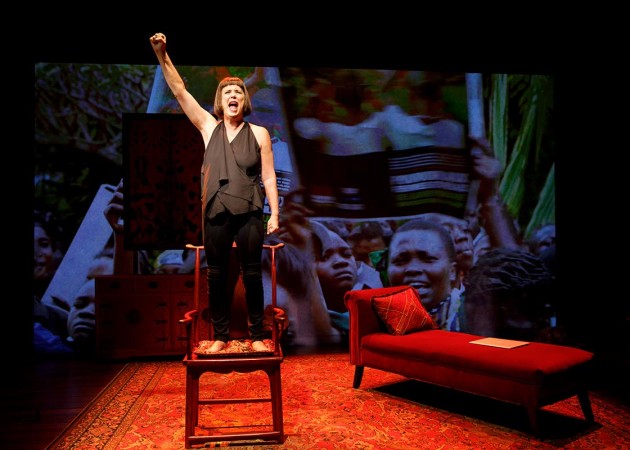The Lilith Blog 1 of 2
February 9, 2018 by Ali Walensky
Your Jewish and Frankly Feminist Review of Eve Ensler’s New Play

Eve Ensler performing her new show, “In the Body of the World.” Photo credit: Joan Marcus.
“Do you know what this show is about?” asked my partner, Elan. He knows I don’t like knowing what shows are about before I go in. It makes me feel like I’m waiting for something or expecting something. I already knew it was written by Eve Ensler and that was enough.
Cancer. The show was about cancer. That’s what Elan wanted me to know going in. He was trying to prepare me, give me a trigger warning, because I beat breast cancer last year. That warning wasn’t needed. Ensler was able to take care of her audience with humor and community in this one-woman show.
Eve Ensler’s new play, In the Body of the World, had its regional premier at the Manhattan Theatre Club on February 6. Ensler starts by talking about her body and how to find her reference point which leads to a discussion of her work in the Democratic Republic of Congo. She and her team were looking for resources to create the City of Joy, “A sanctuary for healing. A revolutionary center where [women] would turn their trauma and pain into power.” Then, doctors find a tumor in Ensler’s uterus.
Throughout the show Ensler has the audience laughing at the morbid subject, whether it’s talking about “Dr. Handsome” examining her ass, making the audience get up and dance during her “tree party”, or giving credit to Cindy, the volunteer “fart deliverer.” At the same time, she doesn’t let us off easy. She reminds us that what we think of as trauma in America doesn’t even compare to trauma in other parts of the world. “Cancer is rarely talked about in Congo. The word is hardly used. When people get it, it is usually too late as there is no CAT scan machine in all of Bukavu.” She describes a graphic flashback of a woman, Angelique, who was forced to eat a boiled fetus cut out of another woman’s body in order not to get shot in the head. This scene occurs after Enlser talks about violently vomiting for three days following a colon operation. We are reminded that pain is relative when the nurse asks Ensler what her pain level is. “It all depends on 10.”
While everyone’s experience with cancer is different, much like how everyone’s vagina is different, Ensler speaks a few thoughts that I believe go through the heads of many cancer patients, including myself: “Why did I get this?” “Will it come back?” and the guilt of feeling like you should be doing more even though you’re sick or that you’re not sick enough to complain. Unlike The Vagina Monologues, this play is only about Ensler herself and her experience, which is fitting for the subject of the show. When going through cancer (or even after), you want to pay homage to the people who helped you, whether they be doctors, friends and/or family, but it is also your time to be selfish and invite care into your life. “This will be good for you, Eve,” Ensler says, impersonating her sister, Lu. “You will learn to be a patient. You’ve never been a patient.”
Ensler draws parallels between the trauma of cancer and other traumas she’s experienced in her life. She mentions a “rock and roll surgeon dude” who shoves a needle into her surgical wound to drain an abscess. He doesn’t seem to notice as she screams in pain, or he just doesn’t care. “He might as well put his hand over my mouth,” she remarks. “He might as well tell me not to scream, not to tell. He might as well remind me I am not even really here.” Sentiments that many people, unfortunately, can relate to.
Jen Schriever’s lighting design provides visual cues for those watching the performance. Lights are often up on both Ensler and the audience as a way of making us participants of the story, allowing us to react audibly, such as at the beginning of the show when Ensler is sharing stories about brutal rape in the Congo and the audience gasps almost in unison. When the lights go black on the audience it’s a way of helping us understand that right now we are spectators, watching behind the fourth wall, as Ensler shows us her experiences, including her first visit to “Cancer Town”.
Director Diane Paulus does a beautiful job weaving the stories together through visuals like Finn Ross’s projections and by using the chaise as different pieces of furniture (hotel bed, hospital gurney, living room couch, etc.) The artistic design hints at the spiritual aspect of Ensler’s journey and allows the stories to flow seamlessly into each other.
The humor comes through the fact that we know Ensler is alright in the end. She is standing in front of us, telling her story, letting us know “Look! I’m alive!” She invites us up on stage to tour her jungle garden after informing us that the City of Joy was built. We enter the garden leaving with a new appreciation of our own lives.
The views and opinions expressed in this article are the author’s own and do not necessarily reflect those of Lilith Magazine.
 Please wait...
Please wait...